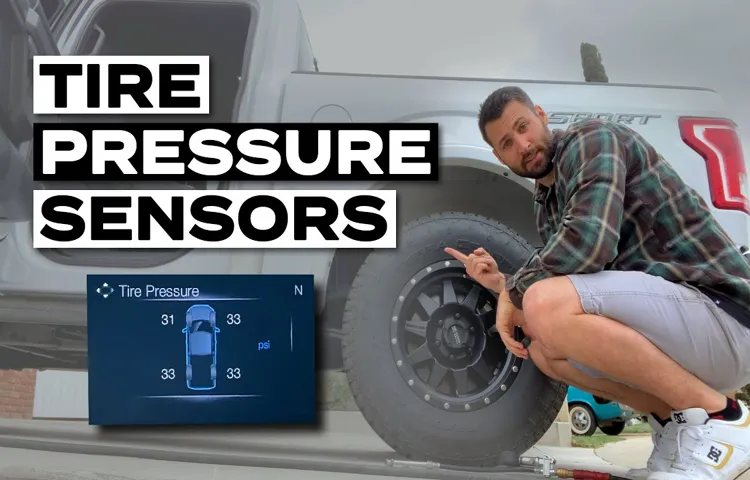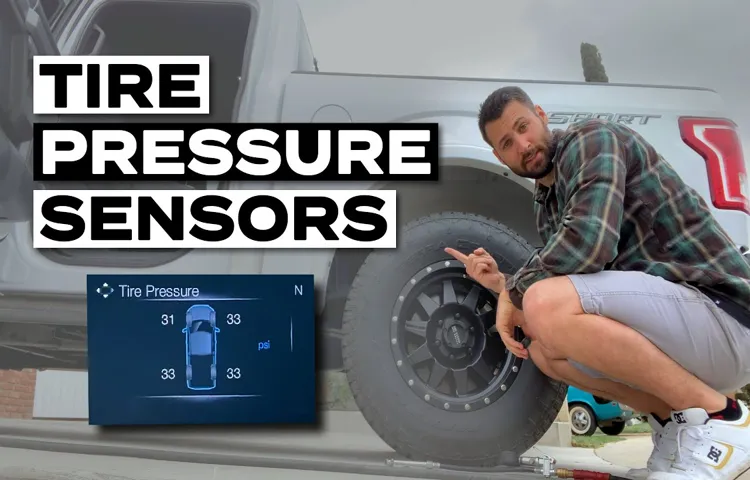Do you ever feel like your tire pressure sensor is constantly on the fritz? Perhaps your Ford F150’s dashboard is persistently lighting up with tire pressure warnings, even when you’ve just refilled them. It can be frustrating and confusing, especially if you’re not sure why it’s happening. Fortunately, there are several reasons for a tire pressure sensor fault on a Ford F150 that are relatively simple to fix.
Rather than having to take your truck in for expensive repairs or replacement parts, you might be surprised at what you can do on your own to take care of the issue. In this blog, we’ll dive into the common causes of a tire pressure sensor fault on a Ford F150 and what you can do to fix it yourself. We’ll explain why the problem might be happening, how to troubleshoot different scenarios, and what tools or steps you might need to take.
By the end of this guide, you’ll feel empowered and confident in being able to tackle this issue head-on, saving you time and money in the process. So if you’re ready to get a grip on that troublesome sensor, keep reading to find out more!
Table of Contents
Understanding Tire Pressure Sensor Faults
If you’re a proud owner of a Ford F150, then you might have experienced some tire pressure sensor faults. These issues can be quite frustrating, as they can cause annoying alerts and disrupt your driving experience. However, there are a few things you can do to fix a tire pressure sensor fault on your own.
The first thing you could try is to reset the sensor by using a TPMS (tire pressure monitoring system) reset tool. You can find these tools at your local auto parts store or online. This tool will reprogram your system and should fix any faults.
If the reset doesn’t work, it’s possible that one or more sensors are not working correctly and may need replacement. It’s essential to make sure you’re using high-quality sensors to avoid future problems. If you’re not comfortable working on your vehicle yourself, be sure to seek professional help.
Remember, keeping your tire pressure in check is vital for your safety and the longevity of your tires.
Causes of Tire Pressure Sensor Faults
Tire Pressure Sensor Faults Tire pressure sensor faults can be a major inconvenience for drivers who rely on these sensors to keep their vehicles safe and roadworthy. There are a number of different factors that can contribute to tire pressure sensor faults, including issues with the sensor itself, software glitches, and physical damage to the sensor or the tire. Additionally, environmental factors such as temperature changes and extreme weather conditions can also impact the accuracy and reliability of tire pressure sensors.
To avoid these issues, it is important to regularly check tire pressure and address any concerns or faults as soon as they arise. By staying on top of these issues, drivers can ensure that their vehicles remain safe to drive and avoid more serious problems down the line.

Symptoms of Tire Pressure Sensor Faults
Tire pressure sensor faults can be quite frustrating. Not only do they cause the tire pressure warning light to constantly turn on, but they can also negatively impact your vehicle’s performance. Understanding the symptoms of tire pressure sensor faults is crucial to determining when to take your vehicle to the mechanic for repairs.
Some common signs of a faulty tire pressure sensor include inconsistent readings, slow response time, and a completely non-functioning system. Additionally, some sensors are known for corroding or becoming damaged due to exposure to the elements, which can cause them to malfunction. If you notice any of these symptoms, don’t hesitate to have your vehicle checked out by a trained professional to ensure your tires are properly inflated and your car remains safe to drive.
Fixing Tire Pressure Sensor Faults
If you’re driving a Ford F150 and suddenly notice the tire pressure sensor fault light illuminated on your dashboard, don’t panic! You can fix this issue in a few simple steps. The first thing to do is check your tires’ pressure – you might find that one of them is low or even flat. In this case, inflate the tire to the recommended pressure level.
If this doesn’t work, try resetting the sensor by holding down the reset button located on the dashboard for a few seconds. Another solution is to replace the sensor entirely, but make sure you purchase one that’s compatible with your F150 model year. These simple steps could save you from an unpleasant surprise on the road.
So, if you ever spot the tire pressure sensor fault, remember to remain calm and take the necessary steps to fix it.
Check Tire Pressure
One of the most crucial maintenance steps for your vehicle is checking the tire pressure regularly. It not only ensures a smooth and comfortable ride but also enhances the safety of your vehicle. However, sometimes low tire pressure warnings can pop up on your dashboard even if the tires are adequately inflated.
This may happen due to a fault in the tire pressure sensor. These sensors may malfunction due to various reasons, including battery failure or physical damage. It is advisable to consult a professional mechanic to diagnose and fix the issue promptly.
Ignoring the warnings and continuing to drive with a faulty sensor can lead to inaccurate readings, affecting the performance and efficiency of your tires and, ultimately, your vehicle. By regularly checking your tire pressure and fixing any sensor faults, you can drive confidently and enjoy a seamless ride.
Visually Inspect the TPMS Components
When it comes to fixing tire pressure sensor faults, one crucial step is visually inspecting the TPMS components. This means taking a closer look at each aspect of the sensor to identify any potential issues. From checking the valve stem to examining the sensor battery, a thorough inspection can help pinpoint the cause of the fault.
It’s important to look for any signs of wear and tear, such as cracks or corrosion, as these can indicate a problem with the sensor itself. Additionally, checking the sensor’s position and mounting can ensure that it is properly installed and positioned for optimal performance. By carefully inspecting each component of the TPMS, you can better diagnose and address any issues with your tire pressure sensor system, keeping your vehicle running safely and efficiently.
So, next time you notice a sensor fault, start by visually inspecting the TPMS components for any noticeable defects or wear and tear.
Reset the TPMS System
If your tire pressure monitoring system (TPMS) is acting up, it may be time to reset it. This process is relatively simple and can oftentimes fix any issues you may be experiencing. First, inflate your tires to the recommended pressure level for your vehicle (which can typically be found in your owner’s manual or on the driver’s side door jamb).
Then, locate the TPMS reset button, which is often located under the steering wheel or in the glovebox. Press and hold the button until you see the TPMS light on your dashboard blink. This indicates that the system has been reset and should be functioning properly.
Keep in mind that some vehicles may require a professional TPMS reset, so don’t hesitate to reach out to a mechanic if you’re still experiencing issues. By resetting your TPMS system, you can ensure that your vehicle is running safely and smoothly on the road.
Replace Faulty TPMS Components
If you’re dealing with a malfunctioning tire pressure monitoring system (TPMS), it’s crucial to replace any faulty components. A faulty TPMS can cause serious issues, from compromising your safety on the road to reducing your vehicle’s fuel efficiency. So, don’t hesitate to seek professional assistance if you’re experiencing any TPMS alerts, such as the dreaded low tire pressure warning light.
This may indicate a faulty sensor, valve stem, receiver, or other important TPMS component. Fortunately, replacing these parts can be a quick and relatively straightforward process that can potentially save you a lot of trouble and expense down the line. Just be sure to work with a trusted mechanic who specializes in TPMS repair and replacement to ensure the job is done correctly and reliably.
Professional Help for Complex TPMS Issues
If you’re experiencing a tire pressure sensor fault on your Ford F150, it can be a frustrating and potentially dangerous issue. While there may be some DIY solutions out there, if you’re dealing with a complex TPMS issue, it’s best to seek out professional help. Trained technicians have the specialized tools and knowledge needed to diagnose and fix the problem.
Plus, they’ll be able to ensure that the repair is done correctly the first time, avoiding costly and time-consuming repeat visits. So don’t let a TPMS issue linger – if you’re unsure about how to fix tire pressure sensor fault Ford F150, reach out to a trusted automotive professional for assistance.
When to Consult a Mechanic
As a vehicle owner, you may encounter issues with your Tire Pressure Monitoring System (TPMS). While some of these issues can be resolved by simple troubleshooting, others may require the attention of a professional mechanic. If you’re experiencing complex TPMS issues such as inconsistent readings or error alerts that won’t go away, it’s best to consult a mechanic who can perform a thorough diagnosis.
Professionals have the necessary tools and expertise to identify the root cause of the problem and provide a viable solution. Attempting to fix intricate TPMS problems can be costly and time-consuming, and may even result in further damage to your vehicle. Therefore, don’t hesitate to seek professional help for complex TPMS issues.
Remember, keeping your TPMS in good condition is essential to ensure your safety and the longevity of your vehicle’s tires.
Preventing Future TPMS Faults
If you own a Ford F150, you may have experienced tire pressure sensor faults. These faults often occur due to low battery levels in the sensors or faulty sensors themselves. One way to prevent these issues is to regularly check your tire pressure and inflate them to the recommended level.
Additionally, try to avoid driving on rough terrains or hitting curbs as this can damage the sensors. If a TPMS fault does occur, it’s best to take your vehicle to a certified mechanic who can diagnose and fix the issue correctly. Ignoring the issue may lead to further damage to your vehicle’s tires and suspension, ultimately costing you more money in the long run.
By being proactive and diligent in maintaining your TPMS sensors, you can avoid these faults and enjoy a smoother driving experience in your Ford F150.
Regular Tire Inspection and Maintenance
Regular tire inspection and maintenance is crucial for avoiding TPMS faults in the future. There are several steps you can take to ensure your tires are in prime condition for safe driving. Firstly, always make sure to check your tire pressure at least once a month to prevent any underinflated tires.
Secondly, keep an eye out for any signs of wear and tear, such as cracks or bulges, which could be indicative of a faulty tire. Lastly, be sure to regularly rotate your tires to ensure even wear, which can prolong their lifespan and avoid the need for replacements. Just as you wouldn’t neglect the health of your body by skipping regular check-ups, ignoring tire maintenance can lead to preventable and potentially dangerous issues on the road.
By taking these simple steps, you can avoid future TPMS faults and drive with confidence.
Check Tire Pressure Before Driving
Before hitting the road, it’s always important to check your tire pressure. This simple step can save you from experiencing TPMS (tire pressure monitoring system) faults in the future. Your car’s TPMS is responsible for alerting you when your tire pressure is low.
If ignored, low tire pressure can cause uneven wear and tear, decrease fuel efficiency, and even lead to a blowout. So, before you start driving, take a few minutes to check the pressure in each tire with a tire gauge or use your car’s built-in TPMS display. By doing this, you’re not only preventing future TPMS faults, but also ensuring a smoother, safer, and more fuel-efficient ride.
Remember, a little prevention can go a long way!
Replace Aging TPMS Components
TPMS components If you’re noticing issues with your vehicle’s tire pressure monitoring system (TPMS), it may be time to replace some aging TPMS components. TPMS sensors and batteries have a lifespan of around 5-7 years, so if your vehicle is nearing that age, it’s important to consider replacing these parts to prevent future TPMS faults. A faulty TPMS system can lead to incorrect tire pressure readings and even compromise your safety on the road.
By replacing your aging TPMS components, you’ll have peace of mind knowing that your system will work efficiently and accurately. Don’t wait for a TPMS fault to occur – take proactive measures to maintain the health of your vehicle’s TPMS system.
Use Recommended Tires and Wheels
One way to prevent future TPMS faults is to use recommended tires and wheels. These recommendations are based on the vehicle’s specific make and model, ensuring that the tires and wheels are compatible with the TPMS system. Using non-recommended tires or wheels can cause the TPMS sensors to fail, leading to inaccurate readings or complete system failure.
It’s important to note that not all tires and wheels are created equal, and investing in high-quality ones may actually save money in the long run by preventing TPMS faults and potentially more costly repairs. Think of it like buying quality shoes for a long hike – investing now can prevent blisters and discomfort later on. So, before purchasing tires or wheels, always check the manufacturer’s recommendations to ensure a smooth, safe, and TPMS-trouble-free ride.
Conclusion
If your Ford F150 is giving you tire pressure sensor faults, don’t sweat it! With a few simple steps, you can fix the problem and get back on the road in no time. Start by checking your tire pressure and making sure it’s at the recommended level. If that doesn’t work, try resetting the sensors or replacing any faulty components.
And if all else fails, just remember: as annoying as a tire pressure sensor fault can be, at least your truck isn’t telling you to put on sunscreen or drink more water. Happy driving!”
FAQs
What are the common symptoms of a faulty tire pressure sensor in Ford F150?
Some common symptoms of a faulty tire pressure sensor in Ford F150 include inaccurate tire pressure readings, warning light constantly flashing, and sluggish handling.
Are there any DIY fixes for a tire pressure sensor fault in Ford F150?
Yes, some DIY fixes include checking and adjusting tire pressure manually, resetting the system using Dashboard Setup menu, or replacing the faulty sensor.
What can cause the tire pressure sensor fault in Ford F150?
The tire pressure sensor fault in Ford F150 can be caused due to a variety of reasons such as low tire pressure, damaged sensor, corroded valve stem or fault in the tire pressure monitoring system.
How often should I check the tire pressure sensor in Ford F150?
It is recommended to check the tire pressure sensor in Ford F150 once a month or before taking a long drive to ensure optimal performance.
How much does it cost to repair a tire pressure sensor fault in Ford F150?
The cost to repair a tire pressure sensor fault in Ford F150 can range from $50 to $300 depending on the extent of the damage and the type of sensor that needs replacement.
Can a faulty tire pressure sensor affect the vehicle’s fuel efficiency?
Yes, a faulty tire pressure sensor can affect the vehicle’s fuel efficiency by causing the engine to work harder and consume more fuel.
What can I do to prevent tire pressure sensor faults in Ford F150?
Some preventive measures include regularly checking tire pressure, avoiding potholes, and ensuring proper installation of the sensor during tire replacement.




